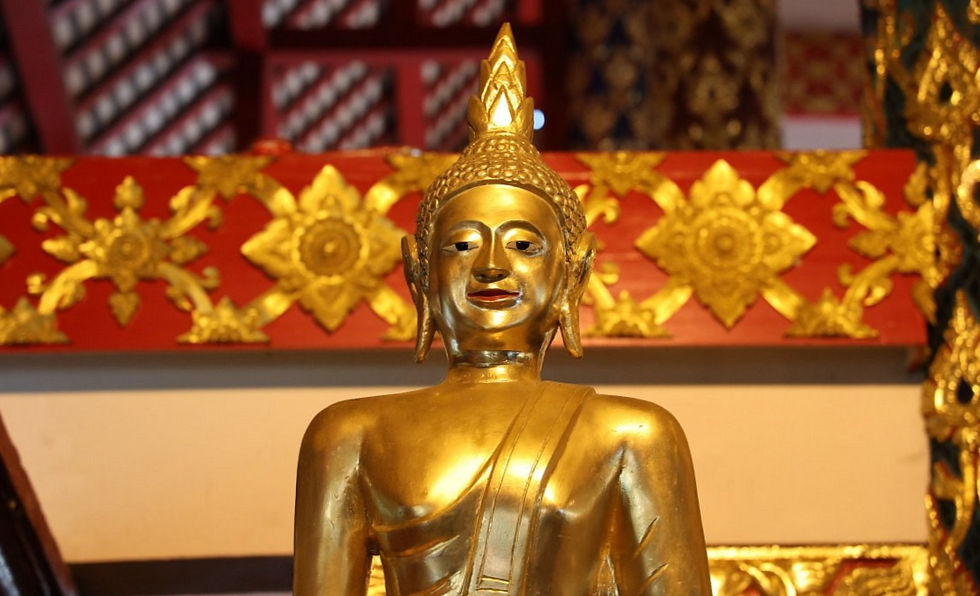Suan Dok Temple
- Shannon
- Oct 23
- 4 min read
Keeper of the Royal Tombs
Wat Suan Dok, the “Flower Garden Temple,” was founded in 1370 by King Kue Na on the grounds of a royal garden, yet even today the site carries a quiet gravity that belies its serene appearance. The temple’s whitewashed chedis gleam under the northern Thai sun but these same structures mark centuries of devotion, death and memory. Encircling the main chedi are royal mausoleums containing the ashes of Chiang Mai’s rulers, a reminder that this temple has long been a bridge between the living and the departed.

The central bell-shaped chedi, completed in 1373, was built to enshrine a fragment of the Buddha’s shoulder bone, a sacred relic brought to Chiang Mai by the monk Phra Sumon Thera. Its Sri Lankan inspired design rises majestically above the temple grounds, while seven headed nāgas guard the ramps, symbolising both protection and solemnity. The chedi’s presence is heightened by the quiet reverence that pervades the site, where every chant and ritual echoes centuries of devotion. Pilgrims have travelled from across the region to venerate the relic, creating a palpable tension between the material and the sacred and linking Wat Suan Dok to its sister site, Wat Phra That Doi Suthep, where another fragment was enshrined atop Doi Suthep Mountain.

Scattered across the grounds are dozens of white chedis serving as royal reliquaries, including those assembled in 1908 by Princess Dara Rasmi, daughter of King Inthawichayanon, who collected the ashes of Chiang Mai’s royal family from multiple cremation sites. Their careful alignment around the central chedi forms a silent, almost sombre procession, a tangible reminder of life’s impermanence even amid grandeur. By centralising the royal remains at Wat Suan Dok, she ensured that Lanna heritage and memory remained inseparably tied to the city’s spiritual heart. During ceremonies, the air between these chedis seems charged, as if the weight of centuries of devotion folds into the present, allowing history itself to participate in the sacred rites.

The open air sermon hall, built in 1932 by Phra Kruba Srivichai, houses a 4.70 metre bronze Buddha statue cast in 1504 during King Mueang Kaeo’s reign. Its Sukhothai style proportions and Ayutthaya influenced robes make it an object of aesthetic and spiritual gravity. In the silence of early morning, the statue can dominate the courtyard with a quiet authority, embodying centuries of monastic discipline and devotion.


Wat Suan Dok’s gardens, which gave the temple its name, were originally part of a royal flower and herb garden, cultivated for both beauty and ceremonial purpose. Winding paths guide visitors past centuries old shade trees, flowering shrubs and small auxiliary shrines, creating a deliberate rhythm that encourages contemplation and mindfulness. Many plants were chosen for ritual significance or medicinal use and quiet corners beneath the trees were traditionally reserved for private meditation by monks. Seasonal changes bring subtle shifts in scent, colour and light, blending the fragrance of blooms with the waft of incense from nearby chedis, so that every step through the garden becomes a sensory reflection of the temple’s spiritual and historical legacy.
The temple’s atmosphere grows particularly intense during morning and evening prayers, when monks chant and the sunlight casts long shadows across the chedis. Visitors often describe a profound sense of presence, as if the past centuries of devotion remain embedded in the air. It is a quiet, haunting weight, neither frightening nor oppressive but inescapably felt, a reminder that Wat Suan Dok is a site where time layers itself upon the sacred.

Ultimately, Wat Suan Dok stands as both a historical monument and a living spiritual centre, where centuries of devotion are woven into every stone, chedi and garden path. Its architecture, royal connections and monastic life converge to create a space where northern Thailand’s history, art and Buddhist practice meet in quiet harmony. The rows of white chedis holding royal ashes, the soaring central chedi and the serene gardens all contribute to its singular aura. Serene, solemn and otherworldly, the temple invites reflection not only on faith and the passage of time but also on the legacy of those who came before and the continuity of devotion in Chiang Mai across centuries, allowing visitors to feel the enduring presence of history in every corner of its sacred grounds.

🗺️ Location
139 Suthep Road, Si Phum, Mueang, Chiang Mai, Thailand
🚆 How to get there
Wat Suan Dok is about 1km or a 15 - 20 minute walk west from the Old City’s Suan Dok Gate. Visitors can also take a taxi or tuk-tuk, with fares typically ranging from 100 - 150 THB or a red songthaew for about 40 THB per person. The Smart Bus R3 line stops nearby, costing around 20 - 30 THB and bicycles can be rented for 50 - 100 THB per day for a 10 - 15 minute ride from the city centre.
⭐ Attraction Info
The temple is open daily between 6am - 9pm and has free admission, though donations are appreciated. Modest attire is required, with shoulders and knees covered and shoes must be removed before entering temple buildings. Visitors can also participate in Monk Chat Sessions on Mondays, Wednesdays, and Fridays from 5:00 PM to 7:00 PM to learn about Buddhism and meditation directly from the monks.
วัดสวนดอก
Thanks for reading about the Suan Dok Temple. Check out more awesome destinations here!



























